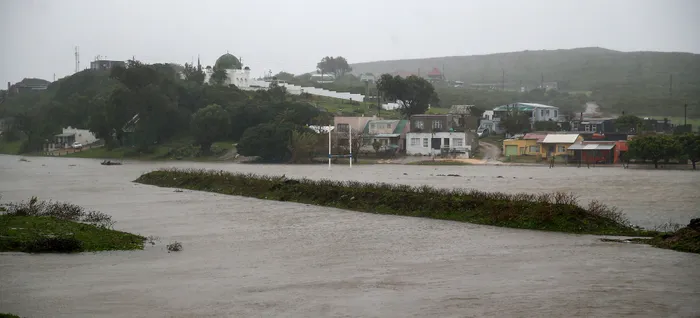Cape Town’s record-breaking rainfall in July sets new highs

In July, multiple areas reported flooding in Cape Town, after a night of heavy rain. Sandvlei on the Cape Flats were also affected. Picture: Leon Lestrade / Independent Newspapers.
Durban — The South African Weather Service (Saws) has documented Cape Town’s record-breaking July 2024 rainfall.
In a statement, Saws said July 2024 saw record-breaking rainfall totals in some areas of the south-western parts of the country, following a slow start to the winter rainfall season.
In June, rainfall accumulation was notably below normal, consistent with seasonal forecasts predicting a drier winter. However, the landscape changed drastically in July, as a series of cold fronts swept through the region, some of which brought severe weather conditions and substantial rainfall.

“An analysis of rainfall data from South African Weather Service (Saws) stations reveals that the Cape Town City (Oranjezicht) station recorded 317.6mm of rain in July 2024, far exceeding the long-term average of 128.0mm for this month. This notable total not only exceeded the historical average, but it is also the highest monthly rainfall recorded for July since comprehensive records began in 1960. In contrast, the previous year saw only 81.8mm of rain in July, highlighting the major difference in rainfall between these two years,” Saws said.
“Additionally, the Cape Town International Airport station recorded the highest monthly rainfall total since the station’s inception in July 1956, exceeding three times the average for July. This remarkable record underscores the intensity and impact of the multiple cold fronts experienced throughout the month.
“A further examination of rainfall stations managed by the Cape Town Weather Office indicates that most recorded well above average rainfall during July, with some stations breaking long-standing records.”

For instance, the Newlands station at the Kirstenbosch National Botanical Gardens received over 500mm of rain for July 2024, making it the wettest month on record for this station since 1999. The stations in Franschhoek, Kenilworth, and Villiersdorp, with records dating back to the late 2000s, also reported significant rainfall for the month.
“These three stations set new records since their inception, even surpassing the total monthly rainfall recorded during the September storm of 2023,” Saws said.
“Additionally, the Cape Winelands stations, including Paarl, Worcester, and Jonkershoek, have experienced substantial rainfall this winter season, with long-term monthly records being broken in these areas last month.”
Saws explained that the transition from a dry start to a series of impactful weather systems reminds them of the complexities of our climate. It also emphasises the importance of their role in providing accurate forecasts and timely updates to the public.
“This recent uptick in rainfall serves as a reminder of the vital role the Saws plays in preparing communities for the varying weather conditions that can arise. The fluctuations in weather patterns do not only keep us on our toes but also highlight the importance of preparedness and resilience!”
Saws added that widespread damage was reported from the start of July well into the month, including strong winds that blew off roofing and minor disruptive hail reported on July 7, in Stellenbosch’s Helshoogte Pass. As usual, thick blankets of snow covered the mountainous areas of the Western Cape, bringing shivering temperatures during this period.

Last month, ‘IOL’ reported that in the first week of July, there were reports of flooding, uprooted trees, power outages, and roofs blown off by gale-force winds. For most parts of the province, rain and winds damaged homes, roads, assets and other infrastructure.
Dam levels across the Western Cape rose during the rainfall. River levels were also of concern.
Eskom also recorded power faults and power interruptions. The storms wreaked havoc and resulted in damages above R16.6 million on power infrastructure alone.
Cemeteries around Cape Town were not spared by the recent flooding in the Western Cape.
WhatsApp your views on this story at 071 485 7995.
Daily News